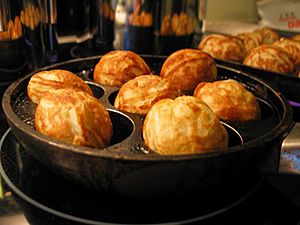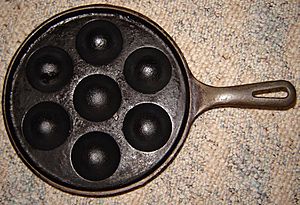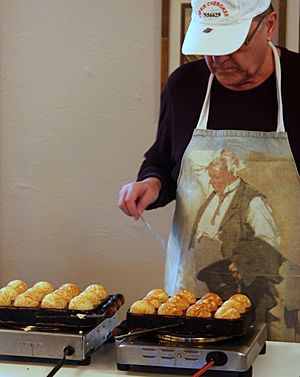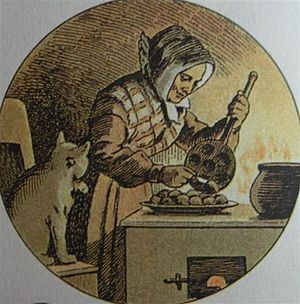Æbleskiver facts for kids

Æbleskiver
|
|
| Course | Dessert, snack |
|---|---|
| Place of origin | Denmark |
| Serving temperature | Hot |
| Main ingredients | Wheat flour, buttermilk, milk or cream, eggs, sugar |
Æbleskiver are yummy Danish snacks that look like little fried balls. Their name means "apple slices" in Danish, even though most don't have apples inside anymore! They have a crust like a European pancake but are soft and fluffy inside, a bit like a Yorkshire pudding. In English, you might see them spelled aebleskiver, ebleskiver or ebelskiver.
Contents
How to Make Æbleskiver
Special Pan for Cooking
Æbleskiver are cooked on the stove using a special pan. This pan has several round dips, like half-spheres. You can find these pans for both gas and electric stoves. Most pans are made of cast iron, which holds heat very well. Older, traditional pans made of hammered copper are mostly used for decoration now.
Mixing the Batter
The batter for æbleskiver usually includes wheat flour. This is mixed with buttermilk, milk or cream, eggs, sugar, and a little salt. Some recipes also add butter, cardamom, and lemon zest for extra flavor. A leavening agent like baking powder or sometimes yeast is added to make the batter light and airy.
Cooking and Serving Tips
You pour the batter into the oiled dips in the pan. As the æbleskiver cook, you turn them with a knitting needle, skewer, or fork. This helps them get their famous round shape. Long ago, they were made with bits of apple or applesauce inside. But today, apples are rarely used in Danish æbleskiver.
Æbleskiver are not very sweet on their own. They are usually served with jam, like raspberry or strawberry, and sprinkled with powdered sugar. Butter, maple syrup, and whipped cream are also popular toppings. You can often buy æbleskiver already fried and frozen from supermarkets. Then you just heat them up in the oven at home.
Æbleskiver Traditions
In Denmark, æbleskiver are a favorite at casual family get-togethers. You can also find them sold by street vendors during the winter. They are traditionally served with jam and powdered sugar, usually three at a time on a plate.
Æbleskiver are a big part of the Christmas season. They are often served with gløgg (a warm Scandinavian drink) or Scandinavian coffee. You'll often see them at Christmas markets, charity events, and local sports gatherings. They are also popular at children's birthday parties because they are easy to make and everyone loves them.
In North America, many yearly events celebrate æbleskiver and Danish culture. Churches and museums often host "Æbleskiver Suppers" and similar fun events.
The History of Æbleskiver
No one knows exactly where æbleskiver came from. One fun story says that Vikings, after a tough battle, wanted to cook pancakes. But they didn't have regular pans. So, they used their shields or helmets, which made the cakes round!
Another idea is that people in the Middle Ages made a special sliced-apple dish. This was a way to use the last apples of the year before they spoiled. The apples were sliced, used to flavor gløgg, then wrapped in dough and fried. This is how they got their name, meaning "apple slices." Later, in the 1600s, cast iron pans with round dips became available. This made it easy to make æbleskiver all year round, and people started using different fillings.
The word "æbleskiver" first appeared in a book of Christmas poems called Peters Jul in 1866. They were also mentioned in an 1872 story by the famous writer Hans Christian Andersen. In the United States, a company called Griswold Manufacturing made pans for æbleskiver.
See also
 In Spanish: Æbleskiver para niños
In Spanish: Æbleskiver para niños






